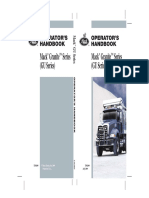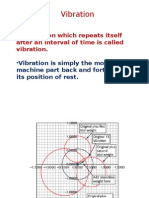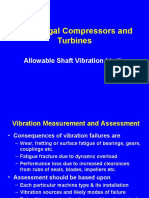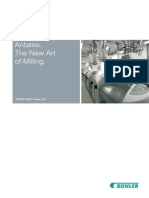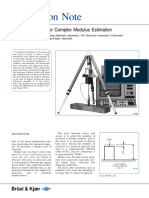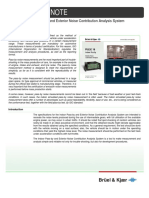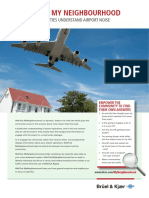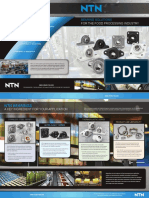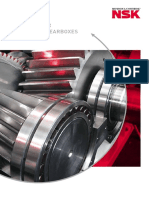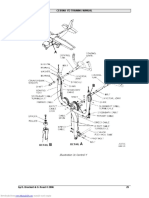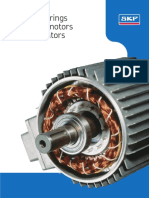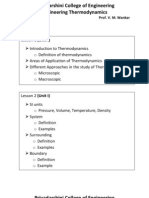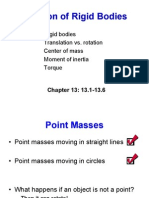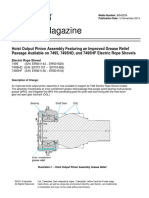Quality-Control of Bearings Using Vibration Monitoring: Application Notes
Quality-Control of Bearings Using Vibration Monitoring: Application Notes
Uploaded by
eng13Copyright:
Available Formats
Quality-Control of Bearings Using Vibration Monitoring: Application Notes
Quality-Control of Bearings Using Vibration Monitoring: Application Notes
Uploaded by
eng13Original Description:
Original Title
Copyright
Available Formats
Share this document
Did you find this document useful?
Is this content inappropriate?
Copyright:
Available Formats
Quality-Control of Bearings Using Vibration Monitoring: Application Notes
Quality-Control of Bearings Using Vibration Monitoring: Application Notes
Uploaded by
eng13Copyright:
Available Formats
Application Notes
Quality-control of Bearings
Using Vibration Monitoring
The- American N T \ Hearing
Manufacturing Corporation at
Schiller
Park
manufactures
deep-groove ball hearings. T h e
outer diameter of the miter
races is ground on a centreless
urinder. T h e quality of the
hearings depends largely on the
balance of the grinding wheel.
'I'he balance of each machine
was checked at hourK intervals
with a hand-held vibration meter but because the balance of
t he \\ heel could change very
quickly. up to an hour's pro
duct ion of badly ground races
could pass down the produclion line before they were delee led.
I
;
j
J
:
A Type 2. )0"> Multipurpose
Monitor was installed on each
grinder
to
detect
Midden
changes in balance. Since the
installation of the T y p e 2-M)~i.
the scrap rale at the plant has
. been halved.
,
Bearing quality greatly depends upon the quality of the grinding wheel. By
permanently monitoring vibrations from the grinding wheel, a tight check can
be kept on its condition
The American NTN Bearing Manufacturing Corporation,
Schiller Park, Illonois
The American NTN Bearing Manufacturing Corporation is a subsidiary
of the NTN Toyo Bearing Company of
Japan. The plant at Schiller Park
manufactures 40 mm, 52 mm and
62 mm Deep-Groove Ball Bearings.
The bearings are standard items in the
NTN catalogue and most will be used
by the automobile manufacturing industry for car alternators, etc. The
plant has 4 production lines, two of
which produce 40 mm bearings. Each
line consists of several grinding operations followed by assembly and testing.
The outer diameter of the outer
races is ground on a centreless grinder
lder
Opat the beginning of each line. This opBO 0245-11
Fig. 1. One of four centreless grinders used to grind the outside diameter of the outer races at
Schiller Park
eration is largely automatic. The quality of the bearings depends largely on
the balance of the grinding wheel.
Normally the grinding wheel would go
out of balance gradually over a period
of 18 hours. Sometimes, however, the
change would be more sudden. Such
sudden changes would be due to a chip
coming off the wheel or a change in
the density of the coolant.
Balancing the Grinding
Wheels
The balance of each machine was
checked at hourly intervals with a
hand-held vibration meter. The balance of the grinder was unacceptable
if the vibration displacement exceeded
3,5 ^m for the 40 mm bearings or 4 /im
for the 62 mm bearings. The wheel
was then balanced so that the vibration did not exceed 1 jum. Initially, the
rebalancing operation could take 5 or
6 hours. The balancing was done by
trial and error and it took some 5 minutes for the wheel to stop before eachi
adjustment. Larry Hackett, the Electrical Engineer at Schiller Park, reduced the balancing time to 20 minutes by installing a dc brake on each
machine.
The hand-held vibration meter adequately covered the routine case of the3
grinding wheels going out of balance3
2
over a period of time, and the dc
brakes had speeded up the balancingy
operation. The problem of the wheelss
suddenly going out of balance still remained. The problem was made worse3
by the fact that the grinding time dictated the overall rate of production.
The average grinding time was 8 seconds whereas the average assembly/
time was 3 seconds per bearing. The3
mismatch between the grinding time3
and the assembly time meant that the3
newly ground races would often pass3
down the production line immediately. Because the machines were only/
checked periodically, up to an hour's3
production of badly ground races3
could pass down the production line3
before they were detected.
Fig. 2. Diagram of the Type 2505 setup on a centreless grinder
Permanently
ireiiiiaiieiiuy Monitoring
iviuiiiiuriiig the Grinding Wheels
A permanent monitoring system
was needed. The plant already used
Kjser sound level meters
Briiel and Kjaer
and vibration analyzers and so Briiel
and Kjaer were asked to provide a sosoType
lution. Larry Hackett chose the Type
2505 Multipurpose Monitor as the
the
most suitable for the application. The
The
fact that the Type 2505 closes to aa
spfllpH
unit was
was an
nn important
imnnrtant rnnsiHsealed unit
consideration because of the coolant suspended in the air around the grinders.
A permanently-installed "rugged" Industrial Accelerometer Type 8315 was
used for the vibration pick-up. Larry
installed a Type 2505 and 8315 on
each grinder. The alarm level was set
between 2,5 and 3 ^m displacement
depending on the diameter of the race
to be ground. The trip level was set
1 fxra higher. The best position for
measuring vibration had been found
with the hand-held vibration meter.
The 8315 was put in the same position.
The wheels still go out of balance in
18 hours but no longer are there production losses due to sudden changes
of balance. Since the installation of
the Type 2505, the scrap rate at the
plant has been halved.
Fig. 3. The Type 2505 Multipurpose Monitor
You might also like
- How to Rebuild & Modify Rochester Quadrajet CarburetorsFrom EverandHow to Rebuild & Modify Rochester Quadrajet CarburetorsRating: 5 out of 5 stars5/5 (2)
- 2009 Mack Granite Series (GU) Operator's ManualDocument300 pages2009 Mack Granite Series (GU) Operator's Manualsengottaiyan100% (6)
- SOP RM Final 26th Nov 08Document96 pagesSOP RM Final 26th Nov 08Raj Jaiswal100% (10)
- IR ECM350 CrawlairDocument4 pagesIR ECM350 CrawlairCarlos Jorge Sánchez Romero50% (2)
- Model 55000-100 Hydraulic Tubing TongDocument75 pagesModel 55000-100 Hydraulic Tubing TongPrejit Radhakrishna50% (2)
- Advanced Vibration Analysis On Gear Box TrainDocument25 pagesAdvanced Vibration Analysis On Gear Box TrainmitrachintuNo ratings yet
- Shallow Horizontal Anode BedDocument1 pageShallow Horizontal Anode Bedanonymous542No ratings yet
- Rolling_Mill_15_Stand (1)Document4 pagesRolling_Mill_15_Stand (1)jashan07.deep2No ratings yet
- Baylor Elmagco (Composite)Document12 pagesBaylor Elmagco (Composite)opc10100% (2)
- 8 Application of Preditive Maintenance in Kiln MaintenanceDocument41 pages8 Application of Preditive Maintenance in Kiln Maintenanceayaskant751001100% (2)
- High Shear Colloid Mill IOMDocument22 pagesHigh Shear Colloid Mill IOMivan.santanaNo ratings yet
- 2008 M 22 Wainwright Garson PDFDocument6 pages2008 M 22 Wainwright Garson PDFnghiNo ratings yet
- Manual D398 CAT Ajustes EspecificacionesDocument259 pagesManual D398 CAT Ajustes Especificacionescristian100% (7)
- Lord Fan Balancer PresentationDocument32 pagesLord Fan Balancer PresentationEzhil Vendhan PalanisamyNo ratings yet
- Grafica de Medidas para Recesion de Valvulas G3400Document3 pagesGrafica de Medidas para Recesion de Valvulas G3400carlos angelNo ratings yet
- Suzler Large Steam TurbineDocument3 pagesSuzler Large Steam Turbineramnadh803181100% (1)
- Daewo Matiz2Document54 pagesDaewo Matiz2hipo84575% (4)
- 3x1600 MAINTENANCE OF CTLDocument16 pages3x1600 MAINTENANCE OF CTLDaniel GuzmanNo ratings yet
- FAN-SOUND and Vibration, BalancingDocument33 pagesFAN-SOUND and Vibration, BalancingSarah FrazierNo ratings yet
- Inverter Microprocessor-Controlled: Certified Kubota Mfg. CorpDocument4 pagesInverter Microprocessor-Controlled: Certified Kubota Mfg. CorpTotok SurotoNo ratings yet
- FL SmidthDocument4 pagesFL SmidthTanmay MajhiNo ratings yet
- FL Smidth PDFDocument4 pagesFL Smidth PDFTanmay Majhi100% (1)
- Psi Max2000 AgitatorsDocument167 pagesPsi Max2000 Agitatorssaipem880% (1)
- Crusher House OperationDocument21 pagesCrusher House Operationratan das0% (1)
- Place For Title: Resolving Cyclic Vibration On An Instrument Air CompressorDocument19 pagesPlace For Title: Resolving Cyclic Vibration On An Instrument Air CompressorMuhammad Fahmi Mahmud100% (1)
- Continous MinerDocument27 pagesContinous MinerSohil Bakshi100% (1)
- Slitting Maintenance DocumentDocument17 pagesSlitting Maintenance DocumentDaniel GuzmanNo ratings yet
- First Aid Treatment For Machine Vibration Problems - Maintenance and EngineeringDocument4 pagesFirst Aid Treatment For Machine Vibration Problems - Maintenance and EngineeringyaserNo ratings yet
- G Series Industrial and Chemical Owners ManualDocument20 pagesG Series Industrial and Chemical Owners ManualbayuNo ratings yet
- Online Monitoring DevicesDocument17 pagesOnline Monitoring Devicesyogi_swarnNo ratings yet
- Shaft Vibration EUDocument24 pagesShaft Vibration EUWildan Harun100% (2)
- Hammer Crusher User ManualDocument10 pagesHammer Crusher User ManualJuan MoralesNo ratings yet
- YamahaDocument32 pagesYamahaNitinChaudharyNo ratings yet
- AttritorDocument4 pagesAttritorimrancenakkNo ratings yet
- SMICO Shale-Shaker-Manual-COLOR PDFDocument12 pagesSMICO Shale-Shaker-Manual-COLOR PDFmojtaba_m007No ratings yet
- Torsional Onboard Swire Pacific MV TitanDocument21 pagesTorsional Onboard Swire Pacific MV TitanRashyd RidhaNo ratings yet
- Cane Shredder 3Document3 pagesCane Shredder 3Dirajen Pullay MardayNo ratings yet
- Brake Lathe HUNTER 3937TDocument8 pagesBrake Lathe HUNTER 3937TjifijifiNo ratings yet
- Product and Maintenance Efficiency by Applying A New Concept For Pinch-Roll ChangeDocument8 pagesProduct and Maintenance Efficiency by Applying A New Concept For Pinch-Roll Changetiago.trad6924No ratings yet
- Caterpillar Cb214e 224e 225e Specalog 1032 Eng (01f)Document12 pagesCaterpillar Cb214e 224e 225e Specalog 1032 Eng (01f)Huayta Apaza JacintoNo ratings yet
- Alert: Catastrophic Failure of Mud Centrifuge Alert 5-20Document1 pageAlert: Catastrophic Failure of Mud Centrifuge Alert 5-20Sergio SantosNo ratings yet
- Valve Stem ProjectionDocument2 pagesValve Stem Projectionjose luis rattiaNo ratings yet
- OverhaulDocument7 pagesOverhaulAniekanNo ratings yet
- Maintenance Management of Equipment in Coal MinesDocument39 pagesMaintenance Management of Equipment in Coal MinesDr-Narayan Acharya100% (2)
- Mechanical Kiln InspectionDocument6 pagesMechanical Kiln Inspectionatliboy100% (8)
- F - Sand Testing Lite 0521Document8 pagesF - Sand Testing Lite 0521IANNo ratings yet
- User Instructions Bull Wheel Liners 4-2010Document8 pagesUser Instructions Bull Wheel Liners 4-2010Alexander SladeNo ratings yet
- DREDGER - SPECIFICATIONS - OIS As Sent by MD's Office.Document16 pagesDREDGER - SPECIFICATIONS - OIS As Sent by MD's Office.oguchejohn01No ratings yet
- 3 - Presentacion WhipstockDocument40 pages3 - Presentacion WhipstockIsaac Almeida100% (2)
- Condition Monitoring Case StudiesDocument21 pagesCondition Monitoring Case StudiesGirish AralikattiNo ratings yet
- Bowel Mill Inspection Guide LineDocument10 pagesBowel Mill Inspection Guide Linesen_subhasis_58No ratings yet
- Molino de Rodillos Buhler PDFDocument8 pagesMolino de Rodillos Buhler PDFniltonrendon8120No ratings yet
- Guia de Compresores SULLAIRDocument32 pagesGuia de Compresores SULLAIRdany riversNo ratings yet
- Engine 3.0 v6Document130 pagesEngine 3.0 v6Wlises GonzalezNo ratings yet
- ADocument36 pagesAsaad bin sadaqatNo ratings yet
- How to Run a Lathe - Volume I (Edition 43) The Care and Operation of a Screw-Cutting LatheFrom EverandHow to Run a Lathe - Volume I (Edition 43) The Care and Operation of a Screw-Cutting LatheRating: 4.5 out of 5 stars4.5/5 (2)
- Machines, Tools and Methods of Automobile ManufactureFrom EverandMachines, Tools and Methods of Automobile ManufactureRating: 4 out of 5 stars4/5 (1)
- Industrial Electric Motors: Installation, Running, Advanced Maintenance and ReliabilityFrom EverandIndustrial Electric Motors: Installation, Running, Advanced Maintenance and ReliabilityNo ratings yet
- Tractor Principles: The Action, Mechanism, Handling, Care, Maintenance and Repair of the Gas Engine TractorFrom EverandTractor Principles: The Action, Mechanism, Handling, Care, Maintenance and Repair of the Gas Engine TractorNo ratings yet
- A DIY'ers Definitive Guide to Building a Custom Volkswagen TrikeFrom EverandA DIY'ers Definitive Guide to Building a Custom Volkswagen TrikeNo ratings yet
- The Book of the Singer Junior - Written by an Owner-Driver for Owners and Prospective Owners of the Car - Including the 1931 SupplementFrom EverandThe Book of the Singer Junior - Written by an Owner-Driver for Owners and Prospective Owners of the Car - Including the 1931 SupplementNo ratings yet
- Complex Modulus Estimation PDFDocument8 pagesComplex Modulus Estimation PDFeng13No ratings yet
- Indoor Passby SystemDocument6 pagesIndoor Passby Systemeng13No ratings yet
- Aerodinamic Noise PDFDocument8 pagesAerodinamic Noise PDFeng13No ratings yet
- Food Designed BearingsDocument2 pagesFood Designed Bearingseng13No ratings yet
- Webtrak - : My NeighbourhoodDocument2 pagesWebtrak - : My Neighbourhoodeng13No ratings yet
- Reliable Packaging Equipment Design Should Not Be Kept Under WrapsDocument2 pagesReliable Packaging Equipment Design Should Not Be Kept Under Wrapseng13No ratings yet
- Precision Machine Tool BearingDocument4 pagesPrecision Machine Tool Bearingeng13No ratings yet
- Advanced Bearing Technologies & Value-Added ServicesDocument5 pagesAdvanced Bearing Technologies & Value-Added Serviceseng13No ratings yet
- Food Processing BearingsDocument2 pagesFood Processing Bearingseng13No ratings yet
- Bearing For GearboxDocument32 pagesBearing For Gearboxeng13100% (1)
- Cesna 172Document7 pagesCesna 172eng13No ratings yet
- Bo 0409Document8 pagesBo 0409eng13No ratings yet
- Industrial Electrical HandbookDocument122 pagesIndustrial Electrical Handbookeng13100% (3)
- Sound Power Determination With or Without IS09614-1: by Erik Cletus Petersen, Bruei&Kjser, DenmarkDocument2 pagesSound Power Determination With or Without IS09614-1: by Erik Cletus Petersen, Bruei&Kjser, Denmarkeng13No ratings yet
- Bearings For Food and BeverageDocument7 pagesBearings For Food and Beverageeng13No ratings yet
- G. Polt, T. Sebesty, A. Pauschitz and F. Franek: Investigations of Stick-Slip Effects in Wet Friction Drive ElementsDocument6 pagesG. Polt, T. Sebesty, A. Pauschitz and F. Franek: Investigations of Stick-Slip Effects in Wet Friction Drive Elementseng13No ratings yet
- Katalog Welding Machine LengkapDocument25 pagesKatalog Welding Machine LengkapAhmad NajihullahNo ratings yet
- HD 191 Bladder TankDocument5 pagesHD 191 Bladder TankPiyush JainNo ratings yet
- Analysis 4Document1,128 pagesAnalysis 4rama_6cpNo ratings yet
- PCV-2013 DatasheetDocument1 pagePCV-2013 DatasheetraufyNo ratings yet
- ch08 - Metal CastingDocument108 pagesch08 - Metal Castingarju antonyNo ratings yet
- C3 Hydraulic DiagramDocument1 pageC3 Hydraulic DiagramMiguel GutierrezNo ratings yet
- Diamond Turning, Micro Machining and Hybrid MachiningDocument101 pagesDiamond Turning, Micro Machining and Hybrid MachiningShambhavamNo ratings yet
- MTII 11-4129 LT-650 - Parts ManualDocument330 pagesMTII 11-4129 LT-650 - Parts ManualAdan BenitezNo ratings yet
- CBSE Class 9 MotionDocument9 pagesCBSE Class 9 MotionDhananjay karadNo ratings yet
- Cat - Filters: Item P/N Code Q'T NoteDocument3 pagesCat - Filters: Item P/N Code Q'T NotehaniNo ratings yet
- Hook Pallet Capacity CalculationDocument2 pagesHook Pallet Capacity CalculationrustamriyadiNo ratings yet
- 605 00 242 AWL Tuning Guide RevBDocument12 pages605 00 242 AWL Tuning Guide RevBJuju RafaelNo ratings yet
- Archemede's Principle LabDocument3 pagesArchemede's Principle LabAnneilia CampbellNo ratings yet
- DHV - Swing Check ValvesDocument5 pagesDHV - Swing Check ValvesAndry HermawanNo ratings yet
- What Is Agricultural Material HandlingDocument4 pagesWhat Is Agricultural Material HandlingpawanNo ratings yet
- Research On Servo Oil Common Rail System For Marine Diesel EngineDocument8 pagesResearch On Servo Oil Common Rail System For Marine Diesel Enginemister_no34No ratings yet
- Six-Way Zone Valves: Usage Point Usage Point Usage Point Usage PointDocument8 pagesSix-Way Zone Valves: Usage Point Usage Point Usage Point Usage Pointconstantin.iacomi3837No ratings yet
- Assignment Unit 1 - 4 Div A & BDocument6 pagesAssignment Unit 1 - 4 Div A & Bmailsk123No ratings yet
- Engineering Thermodynamics Lesson PlanDocument30 pagesEngineering Thermodynamics Lesson PlanVinod Wankar100% (1)
- Physics RigidbodyrotationDocument76 pagesPhysics Rigidbodyrotationsvl3No ratings yet
- 28-Coke-Drum-Econo-End INSPECTION PDFDocument30 pages28-Coke-Drum-Econo-End INSPECTION PDFrohl55No ratings yet
- Pages From B SC Physics Syllabus UG CBCS 2017Document4 pagesPages From B SC Physics Syllabus UG CBCS 2017ShinojNo ratings yet
- Structural ANalysisDocument291 pagesStructural ANalysispairilioNo ratings yet
- Independent Design ReviewDocument11 pagesIndependent Design ReviewdunglxNo ratings yet
- 2015 Service and Maintenance GuideDocument70 pages2015 Service and Maintenance GuidePaul GuillaumeNo ratings yet
- Bomba Vertical Grundfos Crn64 de Sistema de Agua Potable Ku-ADocument5 pagesBomba Vertical Grundfos Crn64 de Sistema de Agua Potable Ku-AJorge Maldonado CocaNo ratings yet
- Cswip 3.2 BookDocument316 pagesCswip 3.2 Bookzahidned90% (21)
- Hoist Output Pinion Assembly Featuring An Improved Grease Relief Passage Available On 7495, 7495HD, and 7495HF ERS - ServiceDocument3 pagesHoist Output Pinion Assembly Featuring An Improved Grease Relief Passage Available On 7495, 7495HD, and 7495HF ERS - ServiceAnonymous ABPUPbKNo ratings yet

